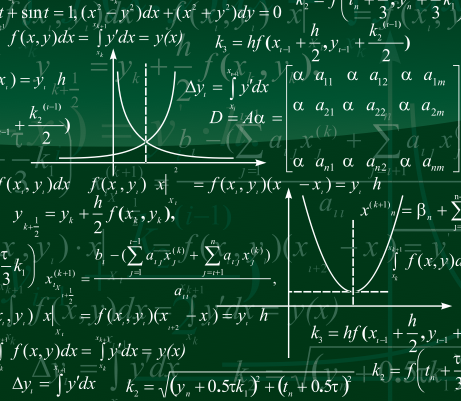What if I told you that there was an alternative to the GRE that included no essays, almost no math, was administered in less than one-third of the time and offered for...
GRE Test Prep: 3 Geometry Concepts to Know
 Let’s look at three math concepts that are very helpful on the GRE’s Quantitative Reasoning sections. Each concept involves triangles. The first concept, triangle inequality, can be used with any triangle. The second concept, Pythagorean Triples, can be used with right triangles. And the third concept, a shortcut for finding the ratio of triangle perimeters or areas, can be used with similar triangles. To illustrate the first concept, we’ll start off with a sample GRE problem.
Let’s look at three math concepts that are very helpful on the GRE’s Quantitative Reasoning sections. Each concept involves triangles. The first concept, triangle inequality, can be used with any triangle. The second concept, Pythagorean Triples, can be used with right triangles. And the third concept, a shortcut for finding the ratio of triangle perimeters or areas, can be used with similar triangles. To illustrate the first concept, we’ll start off with a sample GRE problem.
First Concept: TRIANGLE INEQUALITY
(GRE sample problem) One side of a triangle has a length of 15. Another side of the triangle has a length of 21. Which of the following could NOT be the triangle’s perimeter?
Select ALL that apply.
A. 72
B. 70
C. 48
D. 42
E. 40
Solution:
To determine the triangle’s actual perimeter, we would need the length of the third side, which we are not given. If we knew that the triangle was a right triangle, we could use Pythagorean Theorem, (or in some cases special right triangle side ratios) to find the missing side length. However, nothing in the given information tells us for certain that we’re dealing with a right triangle. Fortunately we can use the concept of triangle inequality to establish a range of possible values for the third side of the triangle, which in turn will tell us the range of possible values for the perimeter.
Imagine a triangle with side lengths a, b, and c. Triangle inequality states that the length of side a must be less than the sum of b and c, yet greater than the difference of b and c, or in other words:
b - c < a < b + c.
The side length designations are completely interchangeable, so “a” could be any of the three sides of the triangle.
Setting up a triangle inequality for the side lengths we’re given in this problem, we simplify and find that:
This in turn tells us that:
Since the perimeter must be greater than 42, but less than 72, we have to select Answer Choices A, D, and E (all that apply) as values that could NOT be the triangle’s perimeter.
Second Concept: PYTHAGOREAN TRIPLES-- A SHORTCUT FOR RIGHT TRIANGLES
Pythagorean triples are sets of 3 integers that can be sides of a right triangle. Pythagorean triples are excellent time-savers because they allow you to solve for a missing side of a right triangle without plugging numbers into the Pythagorean Theorem. You just have to do a little memorization. Here are some of Pythagorean Triples that show up most commonly on tests like the GRE:
Common Pythagorean Triples
3-4-5
6-8-10
5-12-13
7-24-25
8-15-17
Anytime you see a situation in which you could use the Pythagorean Theorem to solve a problem, check to see if you could shortcut the process with a Pythagorean Triple. For example, suppose we’re told that a right triangle has a hypotenuse of length 17 and a leg of length 15, and are asked to find the length of the other leg. Using Pythagorean Theorem, we could set up the following equation:
and solve for x.
HOWEVER, if we realize that a Pythagorean Triple is involved, we would see right away that x = 8. That’s because a leg of length 15 and a hypotenuse of length 17 fit precisely into the “8-15-17” triple in our list of common Pythagorean Triples.
A word of caution when using Pythagorean Triples: Always remember that the biggest number in the triple MUST correspond with the hypotenuse of a right triangle. If the two legs of a right triangle are 8 and 17, for instance, the hypotenuse is NOT 15. Fortunately, if you accidentally misuse a Pythagorean Triple, it’s easy to catch: the mistake will cause you to have a right triangle in which a leg is longer than the hypotenuse, which is impossible. Anyway, in cases where Pythagorean Triples don’t apply, just set up and solve using Pythagorean Theorem.
Third Concept: ANOTHER TRIANGLE SHORTCUT-- RATIOS OF PERIMETERS AND AREAS
You’re probably very familiar with setting up proportions to solve for unknown sides of similar triangles. For instance, if we are told that a triangle which has side lengths of 3, 4, and 5 is similar to a second triangle which has a shortest side with length of 9, we could easily set up proportions to find the other two sides (let’s call them “x” and “y”) of the second triangle:
Solving the proportions, we find that x = 12 and y = 15.
But what if you were asked to find the ratio of the two triangles’ perimeters? It’s easy. You don’t even have to add up all of the sides to get each perimeter. For similar triangles, the ratio of the perimeters is equal to the ratio of two corresponding sides, so in this case we have:
If we are asked to find the ratio of the two triangles’ areas, there’s also a nice shortcut. For similar triangles, the ratio of the areas is equal to the square of the ratio of two corresponding sides, so here we find that:
The word of caution here is that the above shortcuts for perimeter and area ratios only work if the triangles are similar. If you don’t know that the triangles are similar, you have to find the base and height of each triangle, plug them into the triangle area formula, and compare the results to find the ratio.
The three concepts we’ve covered today will help you on GRE Quantitative Reasoning questions. Pythagorean Triples save time and energy, allowing you to avoid unnecessary calculations. Triangle inequality allows you to find answers to questions that would otherwise seem impossible to solve. Ratio shortcuts for similar triangles also save time and allow you to tackle otherwise insoluble problems. Pythagorean Triples are especially common on standardized math tests such as the GRE Quantitative Reasoning section. Practice and master all three concepts and you’ll see a corresponding improvement in your scores. Good luck!
About the Author:
Bill K. is one of MyGuru’s most experienced GRE tutors in Chicago. He scored in the 99th percentile on both the SAT and the GMAT, and has been providing ACT, SAT, GRE, and GMAT tutoring for over five years. He holds a B.A. in Mathematics.

